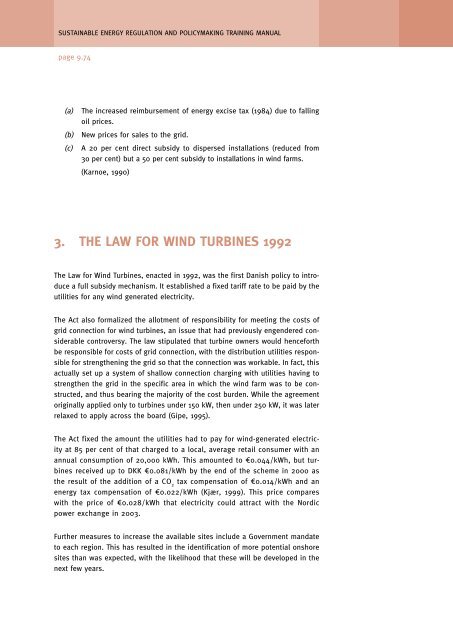Regulatory and policy options to encourage development of ...
Regulatory and policy options to encourage development of ...
Regulatory and policy options to encourage development of ...
- No tags were found...
You also want an ePaper? Increase the reach of your titles
YUMPU automatically turns print PDFs into web optimized ePapers that Google loves.
SUSTAINABLE ENERGY REGULATION AND POLICYMAKING TRAINING MANUALpage 9.74(a)(b)(c)The increased reimbursement <strong>of</strong> energy excise tax (1984) due <strong>to</strong> fallingoil prices.New prices for sales <strong>to</strong> the grid.A 20 per cent direct subsidy <strong>to</strong> dispersed installations (reduced from30 per cent) but a 50 per cent subsidy <strong>to</strong> installations in wind farms.(Karnoe, 1990)3. THE LAW FOR WIND TURBINES 1992The Law for Wind Turbines, enacted in 1992, was the first Danish <strong>policy</strong> <strong>to</strong> introducea full subsidy mechanism. It established a fixed tariff rate <strong>to</strong> be paid by theutilities for any wind generated electricity.The Act also formalized the allotment <strong>of</strong> responsibility for meeting the costs <strong>of</strong>grid connection for wind turbines, an issue that had previously engendered considerablecontroversy. The law stipulated that turbine owners would henceforthbe responsible for costs <strong>of</strong> grid connection, with the distribution utilities responsiblefor strengthening the grid so that the connection was workable. In fact, thisactually set up a system <strong>of</strong> shallow connection charging with utilities having <strong>to</strong>strengthen the grid in the specific area in which the wind farm was <strong>to</strong> be constructed,<strong>and</strong> thus bearing the majority <strong>of</strong> the cost burden. While the agreemen<strong>to</strong>riginally applied only <strong>to</strong> turbines under 150 kW, then under 250 kW, it was laterrelaxed <strong>to</strong> apply across the board (Gipe, 1995).The Act fixed the amount the utilities had <strong>to</strong> pay for wind-generated electricityat 85 per cent <strong>of</strong> that charged <strong>to</strong> a local, average retail consumer with anannual consumption <strong>of</strong> 20,000 kWh. This amounted <strong>to</strong> €0.044/kWh, but turbinesreceived up <strong>to</strong> DKK €0.081/kWh by the end <strong>of</strong> the scheme in 2000 asthe result <strong>of</strong> the addition <strong>of</strong> a CO 2tax compensation <strong>of</strong> €0.014/kWh <strong>and</strong> anenergy tax compensation <strong>of</strong> €0.022/kWh (Kjær, 1999). This price compareswith the price <strong>of</strong> €0.028/kWh that electricity could attract with the Nordicpower exchange in 2003.Further measures <strong>to</strong> increase the available sites include a Government m<strong>and</strong>ate<strong>to</strong> each region. This has resulted in the identification <strong>of</strong> more potential onshoresites than was expected, with the likelihood that these will be developed in thenext few years.










